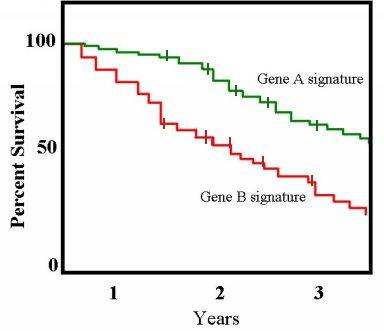Kaplan–Meier estimator
The Kaplan–Meier estimator,[1][2] also known as the product limit estimator, is an estimator for estimating the survival function from lifetime data. In medical research, it is often used to measure the fraction of patients living for a certain amount of time after treatment. In economics, it can be used to measure the length of time people remain unemployed after a job loss. In engineering, it can be used to measure the time until failure of machine parts. In ecology, it can be used to estimate how long fleshy fruits remain on plants before they are removed by frugivores. The estimator is named after Edward L. Kaplan and Paul Meier.
A plot of the Kaplan–Meier estimate of the survival function is a series of horizontal steps of declining magnitude which, when a large enough sample is taken, approaches the true survival function for that population. The value of the survival function between successive distinct sampled observations ("clicks") is assumed to be constant.

An important advantage of the Kaplan–Meier curve is that the method can take into account some types of censored data, particularly right-censoring, which occurs if a patient withdraws from a study, i.e. is lost from the sample before the final outcome is observed. On the plot, small vertical tick-marks indicate losses, where a patient's survival time has been right-censored. When no truncation or censoring occurs, the Kaplan–Meier curve is the complement of the empirical distribution function.
In medical statistics, a typical application might involve grouping patients into categories, for instance, those with Gene A profile and those with Gene B profile. In the graph, patients with Gene B die much more quickly than those with gene A. After two years, about 80% of the Gene A patients survive, but less than half of patients with Gene B.
Formulation
Let S(t) be the probability that a member from a given population will have a lifetime exceeding t. For a sample of size N from this population, let the observed times until death of the N sample members be
Corresponding to each ti is ni, the number "at risk" just prior to time ti, and di, the number of deaths at time ti.
Note that the intervals between events are typically not uniform. For example, a small data set might begin with 10 cases. Suppose subject 1 dies on day 3, subjects 2 and 3 die on day 11 and subject 4 is lost to follow-up (censored) at day 9. Data for the first two subjects would be as follows.
| 1 | 2 | |
|---|---|---|
| 3 | 11 | |
| 1 | 2 | |
| 10 | 8 |
The Kaplan–Meier estimator is the nonparametric maximum likelihood estimate of S(t). It is a product of the form
When there is no censoring, ni is just the number of survivors just prior to time ti. With censoring, ni is the number of survivors less the number of losses (censored cases). It is only those surviving cases that are still being observed (have not yet been censored) that are "at risk" of an (observed) death.[3]
There is an alternative definition that is sometimes used, namely
The two definitions differ only at the observed event times. The latter definition is right-continuous whereas the former definition is left-continuous.
Let T be the random variable that measures the time of failure and let F(t) be its cumulative distribution function. Note that
Consequently, the right-continuous definition of may be preferred in order to make the estimate compatible with a right-continuous estimate of F(t).
Statistical considerations
The Kaplan–Meier estimator is a statistic, and several estimators are used to approximate its variance. One of the most common such estimators is Greenwood's formula[4]:
In some cases, one may wish to compare different Kaplan–Meier curves. This may be done by several methods including:
See also
References
- ^ Kaplan, E. L.; Meier, P.: Nonparametric estimation from incomplete observations. J. Amer. Statist. Assn. 53:457–481, 1958. JSTOR 2281868
- ^ Kaplan, E.L. in a retrospective on the seminal paper in "This week's citation classic". Current Contents 24, 14 (1983). Available from UPenn as PDF.
- ^ John P. Costella, 2010, A simple alternative to Kaplan–Meier for survival curves.
- ^ Greenwood M. The natural duration of cancer. Reports on Public Health and Medical Subjects. London: Her Majesty's Stationery Office 1926;33:1–26.








![{\displaystyle S(t)=P[T>t]=1-P[T\leq t]=1-F(t).\,}](https://wikimedia.org/api/rest_v1/media/math/render/svg/025e8227464c480f59905f7ee7186911513a06a0)

